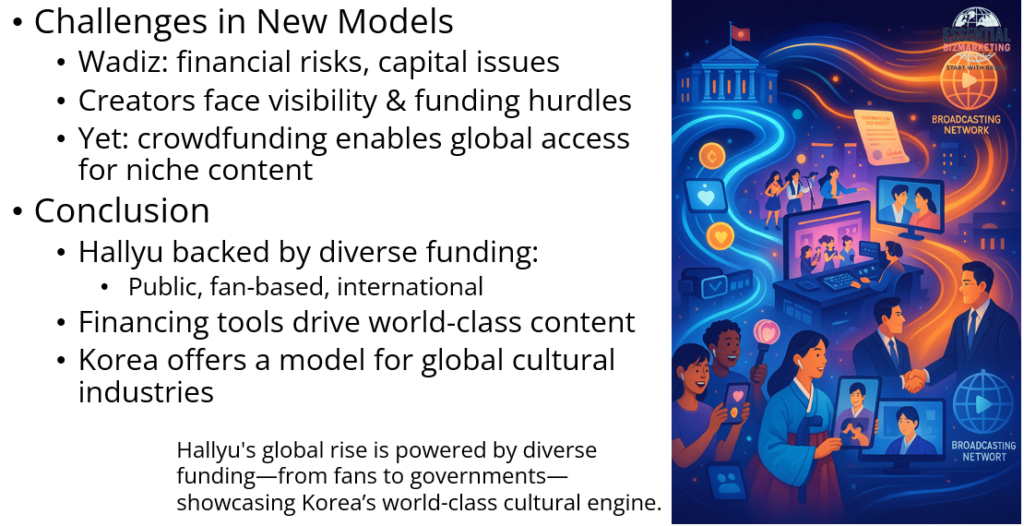Introduction: Financing the Korean Wave

The rapid global rise of Korean content—from K-pop and K-dramas to webtoons and films—has created increasing demand for innovative financing strategies. Traditional production budgets are often insufficient to meet the international quality and scale expected by global audiences. As a result, South Korea has turned to a mix of domestic public funding, crowdfunding platforms, and international investment to sustain and expand its cultural output. These diverse funding streams demonstrate how Hallyu is no longer only a cultural movement but also a globally financed economic engine.
Government Investment in Cultural Content
In October 2024, the South Korean Ministry of Culture, Sports and Tourism partnered with the Ministry of Science and ICT to launch a 600 billion won (approx. $454 million USD) fund to support domestic production of movies, K-dramas, and webtoons. This fund aims to enhance global competitiveness and help producers scale their projects for international distribution. The government views such investment not merely as cultural policy, but as part of a broader soft power strategy that contributes to export revenues and international influence (Korea JoongAng Daily, 2024).
Crowdfunding as a Democratic Financing Tool

Crowdfunding has emerged as a key mechanism that empowers fans to financially support the content they love. Platforms like Makestar, which specializes in K-pop and drama-related campaigns, allow international fans to contribute directly to album production, drama releases, and promotional activities. With users from over 200 countries, Makestar represents a model of decentralized cultural funding that turns fans into stakeholders (Welcon, n.d.).
Meanwhile, Wadiz, Korea’s leading general crowdfunding platform, has funded thousands of projects across categories such as tech, fashion, and media. It collected nearly 250 billion KRW in 2023 alone. Although primarily consumer-product focused, Wadiz has also supported cultural content including short films and indie albums (Statista, 2024; Adriel, n.d.).
Foreign Direct Investment and Streaming Partnerships
Korean content’s global popularity has led to massive foreign investment. Netflix, for example, announced a $2.5 billion USD investment in Korean content production over four years. This includes K-dramas, reality shows, and films targeted at global audiences. Such deals reflect not only international appetite for Korean stories, but also confidence in Korea’s production capabilities and storytelling infrastructure (The Media C-Suite, n.d.).
Challenges in Alternative Financing Models

Despite the opportunities, alternative financing methods come with risks. Platforms like Wadiz face financial sustainability issues, including capital impairment, as they scale operations (Chosun Ilbo, 2024). Creators must also compete for visibility and prove project viability to attract funds. Nonetheless, these challenges are balanced by the democratizing effect of global crowdfunding, which gives niche projects a chance to find global audiences and funding.
Conclusion: Toward a Globalized Funding Ecosystem
The Hallyu industry’s ability to attract funding from government, fans, and international investors reflects its maturity and global appeal. Crowdfunding and co-production investments have become vital tools that support the creation of world-class content. As Korean culture continues to grow in influence, so too does the diversity and complexity of its financing ecosystem—offering a blueprint for other cultural industries seeking global scale.
📚 References
Adriel. (n.d.). Wadiz: Success story. Retrieved from https://www.adriel.com/success-stories/wadiz
Chosun Ilbo. (2024, April 23). Wadiz faces capital impairment amid rapid growth. Retrieved from https://www.chosun.com/english/market-money-en/2024/04/23/KTXRGAJJQZCHBERJVBFQ2GGLOU
Korea JoongAng Daily. (2024, October 2). Korean gov’t launches $454 million fund for Korean movies, K-dramas, webtoons. Retrieved from https://koreajoongangdaily.joins.com/news/2024-10-02/business/industry/Korean-govt-launches-454-million-fund-for-Korean-movies-Kdramas-webtoons/2146713
Statista. (2024). Crowdfunding volume of Wadiz in South Korea from 2016 to 2023. Retrieved from https://www.statista.com/statistics/1129299/wadiz-crowdfunding-amount
The Media C-Suite. (n.d.). Korean entertainment’s global K-wave. Retrieved from https://mediacsuite.com/korean-entertainments-global-k-wave/
Welcon. (n.d.). Makestar crowdfunding platform goods. Retrieved from https://welcon.kocca.kr/en/directory/content/makestar-crowdfunding-platform-goods–2930
📁 Start exploring the Blog
📘 Or learn more About this site
🧵 Or follow along on X (Twitter)
🔎 Looking for sharp perspectives on global trade and markets?
I recommend @GONOGO_Korea as a resource I trust and regularly learn from.
